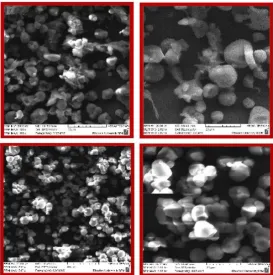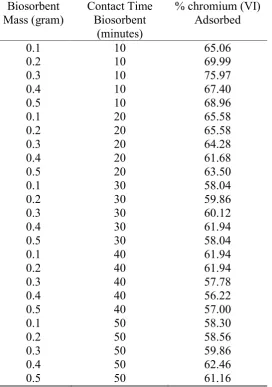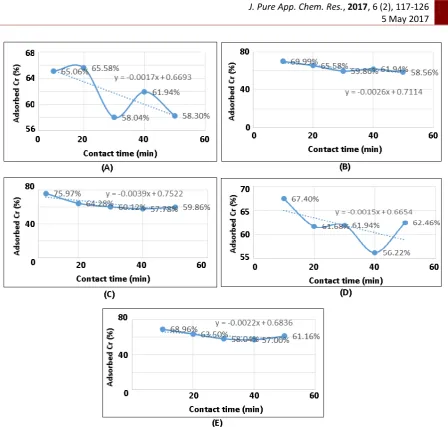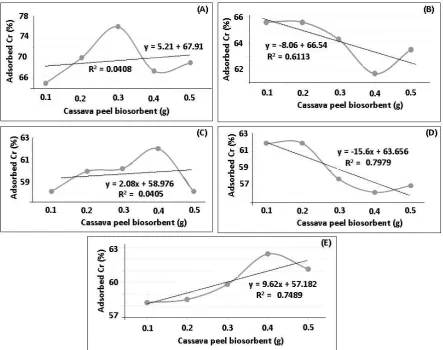The journal homepage www.jpacr.ub.ac.id p-ISSN : 2302 – 4690 | e-ISSN : 2541 – 0733
Absorbtion Activity of Cassava Peel (
Manihot utilissima
) as
Chromium (VI) Metal Biosorbent in Electroplating Waste
Fahimah Martak,1* Iin Candrawati,1 Yurike Ika Cahyo,1
1
Received 1 March 2017 ; Revised 11 April 2017 ; Accepted 11 April 2017
ABSTRACT
Electroplating is a process of metal veneering with another metal using the electric energy. The water waste of electroplating industry contains many kinds of heavy metal ions, especially chromium (VI) which might cause pollutions if it was not processed and it presents above the threshold allowed. The use of cellulose can be a solution, because it has the functional groups which form bonding with the metal ions. Cassava peel is one of the sources of cellulose which contains 80-85% of cellulose. This proves that cassava peel (Manihot utilissimaI) has the potential as the heavy metal biosorbent of chromium metal in electroplating waste. The methodology of the research is conducted in a series including analysis of heavy metal concentrations of chromium (VI) in electroplating waste. Biosorption treatment of cassava peel (Manihot utilissimaI) biosorbent activated by HNO3 1.5 M in electroplating waste conducted in the batch method. Analysis of heavy metal concentrations of chromium (VI) in electroplating waste was performed by Atomic Absorption Spectrophotometry (AAS) after biosorbtion process. Variation of biosorbent mass were (0.1, 0.2, 0.3, 0.4, 0.5) grams, and variation of biosorbent contact time were (10, 20, 30, 40, 50) minutes. The analysis result recorded by AAS (Atomic Absorption Spectrophotometry) showed that the level of total chromium in electroplating waste reaches 2.0777 ± 0.2785 ppm. Accordingly, the chromium test solution used in this research was 2 ppm to measure the optimum conditions of % chromium (VI) adsorbed with variation of mass and contact time. From the results of this research, the optimum mass and contact time of cassava peel biosorbent activated by HNO3 1.5 M in % chromium (VI) adsorbed were 0.1 gram and 40 minutes, respectively. Finally, the optimum mass and contact time of cassava peel biosorbent activated by HNO3 1.5 M has applied to electroplating waste. The % chromium adsorbed in electroplating waste with the addition of cassava peel biosorbent activated by HNO3 1.5 M was measured in average of 61.72%.
Keywords : absorption, electroplating waste, cassava peel, chromium
INTRODUCTION
Chrome in the electroplating industry used in the hard layered process as anti-dullness[2]. Toxicity effect of chrome in the electroplating waste has bioaccumulative properties and cannot be relegated[3]. Chrome causes respiratory disorder, skin irritation, circulatory disorder and kidney disorder[4]. Chrome in the form of Cr (IV) has higher toxicity than Cr (III). People work in some kinds of industry like steel, textile and more included in the electroplating have risk to contact directly to these metals[5,6].
The effectiveness and efficiency of the waste processing technology is very important. One of its ways is biosorption with biosorbent. Recently, it was being developed some kind of absorbents to absorb heavy metal, one of them is cellulose. Cellulose has the functional groups which form bonding with the metal ions. Those functional groups are carboxyl and hydroxyl. We supposed two mechanisms for chrome to bind into cellulose. Firstly, electrostatic interaction between chrome ions and the cellulose occurs in the absence of ligand in the solution, so carboxylic groups of cellulose exchange cations i.e. hydrogen leaves carboxylic groups and chrome ions attaches instead[7,11]. Secondly, chrome ion and co-ligand (ex. ethylene-diamine, ammonia, tartaric acid, etc that exist in the electroplating waste solution) form complexes in solution. In the presence of cellulose which acts as ligand, competition for the chrome ion occurs between ligand and co-ligand. When the stability of metal ion and co-ligand complex is sufficient weak, cellulose complexes with the metal ion are formed and the the co-ligand is released[7,8,12].
Cassava peel is one of the sources of cellulose which is cheap and abundant. It has the cellulose content of 80-85%[24]. This proves that cassava peel (Manihot utilissima) has the potential as the heavy metal biosorbent (Cu, Cd, Pb, and Cr) in electroplating waste[8,9,18].
Cassava peel has the optimum percentage of cell wall materials as the source of metal bonds[24]. Unfortunately, cassava peel waste is not being optimally used as the biosorbent. Therefore, this research aims to exploit the content of the cassava peel as chromium (VI) metal absorbent in electroplating waste so it could increase economic value of the waste itself[10].
EXPERIMENT Research Materials
1 kg of Manihot utilissima was obtained from the agriculture land in Surabaya, 1000 mL of electroplating waste was obtained from electroplating industry in Sidoarjo. Standard solution of chromium used in the concentration of 2 ppm. 100 mL standard solution of HNO3
1.5 M (pro analysis) and 1000 mL demineralized aquadest.
Research Variables
Variations of biosorbent mass were 0.1, 0.2, 0.3, 0.4, and 0.5 grams. Variations of biosorbent contact time were 10, 20, 30, 40, and 50 minutes.
Research Instrument
Instrument used in this research was AAS Spectrophotometry for measuring total absorbed chromium (VI) in liquid. Cassava powder was dried by oven. Buchner funnel was used to filter the suspension.
Research Procedures
homogeneous, and then boiled until was obtained a pure liquid. This process is called a destruction process. The destruction liquid was cooled, then put in 100 mL measuring cylinder and added HNO3 1% until limit mark. And then the total chromium (VI) in liquid
was analysed with AAS.
Cassava Peel (Manihot utilissima) Biosorbent Treatment
Firstly, this step aims to fabricate cassava peel (Manihot utilissima) biosorbent activated by HNO3 1.5 M. The process started by preparing cassava peel which its tuber color
is white, then it was dried and sliced into small size. Then it was grinded until it becomes powder. The cassava powder was heated using oven at 60 °C until it was dry, then it was sieved using sifter 125 μm, and it was washed by aqua DM to leave out cyanide in cassava peel. And the mixture was filtered by buchner funnel, and the result called as residue 1. The residue was heated at 60°C by oven until it was dry, then it was soaked in HNO3 1.5 M for 24
hours to activate the process until it formed a suspension. The suspension was filtered by buchner funnel and washed by aqua DM to leave out an impure compound, and then the result was called as residue 2. The residue was heated at 60 °C until it was dry, then refined with mortar milling until it formed a cassava peel (Manihot utilissima) biosorbent activated by HNO3 1.5 M.
Optimation of Mass and Contact Time of Cassava Peel (Manihot utilissima) Biosorbent
Activated by HNO3 1.5 M in Chromium Liquid using Batch Method
Cassava peel activated by HNO3 1.5 M biosorbent was weighed (0.1, 0.2, 0.3, 0.4, 0.5)
gram, then added in 10 mL Cr6+ 2 ppm liquid whose the pH value same as pH value of electroplating waste. Then it was stirred for about (10, 20, 30, 40, 50) minutes and filtered by whatman filter paper. The 2.5 mL filtrate was diluted in 25 mL measuring cylinder with HNO3 1%. Then it was analyzed using AAS at λ 359.4 nm. The result is % chromium (VI)
adsorbed in chromium liquid. Then it was obtained the optimum mass and contact time of cassava peel activated by HNO3 1.5 M biosorbent.
Analysis of Heavy Metal Concentrations of Chromium (VI) in Electroplating Waste with Cassava Peel (Manihot utilissima) Activated by HNO3 1.5 M Biosorbent
Cassava peel activated by HNO3 1.5 M biosorbent was weighed as its optimum mass
and then put in electroplating liquid in beaker glass and stirred for its optimum contact time. Then it was filtered by using whatman filter paper until it formed a filtrate. The 2.5 mL filtrate was diluted in 25 mL of measuring cylinder with HNO3 1%. Then it was analysed
with AAS at λ 359.4 nm. The result was % chromium (VI) adsorbed in electroplating waste
liquid.
RESULT AND DISCUSSION
Characteristic of Adsorbent material Morphology of Adsorbent
The surface morphology of cassava peel at four different magnifications was presented in Figure 1. The data was cited from [13]. Observation of the cassava peel surface revealed that pore space development within the biomass was very noticeable. Figure 1 confirmed the heterogeneity characteristics and complex nature of cassava peel surface.
Figure 1. SEM micrographs of cassava-peel with four magnifications
FTIR-Analysis
We can symbolize the adsorbent material as B−CH2OH, where B represents biomass
and −CH2OH as active site which can bind metal ions. The FT-IR spectra of biomass
materials were showed below.
Figure 2. FT-IR Spectra of biomass from cassava peel
Adsorption Process
adsorbed with variation of mass and contact time of cassava peel activated HNO3 1.5 M
biosorbent.
The result of this research is showed in form of % chromium (VI) adsorbed in chromium (VI) test liquid in Table 1 below.
Table 1. % chromium (VI) adsorbed in 2 ppm chromium (VI) test liquid with variation of mass and contact time of cassava peel activated by HNO3 1.5 M biosorbent
Biosorbent
The result of this research showed in form of a data of % chromium (VI) adsorbed in chromium (VI) test liquid in the explanations below.
Figure 3. The chart of % chromium (VI) adsorbed in 2 ppm chromium (VI) test liquid with mass variation of cassava peel activated by HNO3 1.5 M biosorbent and constant contact time
in : (A) 10 min, (B) 20 min, (C) 30 min, (D) 40 min, (E) 50 min.
The figures showed that the maximum contact time of each adsorbent was 10 minutes except in 0.1 gram of sorbent shows that the maximum contact time on 20 minutes. The data demonstrate that the maximum removal of chromium (VI) was occurred in the initial stage, which gradually decreased after an optimum period. It was also observed that the adsorption got slowdown in later stages because initially a large number of vacant surface sites may be available for adsorption and after some time, the remaining vacant surface sites may be difficult to occupy due to repulsive forces between the solute molecules of the solid and bulk phase [16,17].
Effect of Biosorbent Dose
The effects of biosorbent dose used in the adsorption process were shown in these following charts.
Figure 4. The chart of % chromium (VI) adsorbed in 2 ppm chromium (VI) test liquid with contact time 10 mins in variation : (A) 0.1 gram, (B) 0.2 gram, (C) 0.3 gram, (D) 0.4 gram, (E) 0.5 gram of cassava peel activated by HNO3 1.5 M.
The results of adsorption using dose of adsorbent variation demonstrate when adsorption process with 10 minutes contact time with maximum dose at dose 0.3 gram of biosorbent. In 10 minutes of contact time, desorption process was occurred when the adsorption process and desorption of Chromium (VI) ion occurs at a dose above of 0.3 gram of adsorbent. At the 20 minute contact time, obtained biosorbent maximum dose used was 0.1 and 0.2 grams at concentrations above the maximum dose biosorbent occur desorption process. At the 30 minute contact time, obtained the maximum contact time at a dose of 0.4 grams and declined sharply at a dose of 0.5 grams. Meanwhile, at a dose of 40 minutes occurred biosorbent ion release chromium (IV) after biosorbent dose of 0.2 grams. At the contact time of 50 minutes, obtained the maximum dose of 0.4 grams and desorption process occurs at a dose of 0.5 grams.
adsorption process achieving maximum dose, the desorption process occurs it was because An increase in biomass dose may lead to interference between binding sites, causing electrostatic interaction between the active site and results in the decrease of total surface area. Hence % removal decreased with increase in biosorbent dose [10,19].
At adsorption using a contact time of 20 and 40 minutes earned the maximum dose at 0.1 grams, stagnating at a dose of 0.2 grams then the desorption process occurs at concentrations above 0.2 gram of adsorbent. So generally it can be seen that the sorption capacity was steady or Decreased with biomass concentration. With further increase in biosorbent dose beyond the optimum level the removal efficiency of metal ions remained almost constant, this may be due to the reaching of equilibrium state at given experimental conditions[8]. It was also because to the screening effect between cells. This phenomenon blocked the cell active sites by an increase of biomass in the system. At low dose of biosorbent, all types of sites are entirely exposed and the adsorption on the surface is saturated faster, showing a higher % removal value. But at higher adsorbent dose, the availability of higher energy sites decrease with a larger fraction of lower energy sites occupied, resulting in a lower %removal and Quantum Efficiency (QE) value.
The phenomena which can also explain the decreasing of chromium adsorption above maximum biosorbent dose that the high biomass concentration could make a “screen” effect on the dense outer layer protecting the binding sites from metal and thereby lowering the specific metal uptake at higher biomass loading[10]. Similarly, it has been reported that adsorption efficiency somewhat decreased with higher doses[12]. All of variation in contact time confirmed that the existing of desorption above maximum dose of biosorbent which considerably reduced the overall rate of removal. The adsorbed ions either blocked the access to the initial pores or caused particles to aggregate, thereby reducing the active site availability [11,21].
Adsorption of Cr(VI) from electroplating wastewater
From the result of the research is % chromium (VI) adsorbed in 2 ppm chromium (VI) liquid. Cassava peel activated by HNO3 1.5 M biosorbent going to be constant when it is
added 0.1 gram of cassava peel activated by HNO3 1.5 M biosorbent. It can be concluded that
optimum mass of cassava peel activated by HNO3 1.5 M biosorbent is 0.3 gram and optimum
contact time is 10 minutes. And then, the mass and contact time optimum of cassava peel activated by HNO3 1.5 M biosorbent can be applied to electroplating waste. The data of %
chromium (VI) adsorbed in electroplating waste below.
Table 2. % Chromium (VI) adsorbed in electroplating waste with mass and contact time optimum of cassava peel activated by HNO3 1.5 M
Sampling time % Adsorbed chromium
24 April 2015 61.938
4 May 2015 60.841
11 May 2015 61.942
18 May 2015 61.941
25 May 2015 61.942
wastewater sample are lower when applied on synthetic sample. In synthetic sample, at optimum mass and contact time of cassava peel activated by HNO3 1.5 M % Chromium
adsorbed is 75.97% and in wastewater sample is 61.72 % in average. The decrease in percent removal may also be attributed due to presence of other metal ions like Cu, Zn, CN, Fe and Ni in wastewater, which may occupy the adsorption sites and therefore lesser Cr(VI) removal occurred. In the synthetic sample of potassium dichromate only Cr(VI) metal ions were present, so the binding sites on adsorbent surface were occupied by the single metal ions, so removal percent is greater than wastewater sample[17,21,22]
CONCLUSION
From the result of the research above it can be concluded that optimum condition of cassava peel biosorbent which is activated by HNO3 1.5 M are 0.3 gram of mass and 10
minutes of contact time. The average of % chromium (VI) adsorbed in electroplating waste with the addition of cassava peel biosorbent which is activated by HNO3 1.5 M is 61.72%.
ACKNOWLEDGMENT
The authors would like to acknowledge the KEMENRISTEK DIKTI for funding this research by Pekan Ilmiah Mahasiswa 2014.
[7] Parvathi, K., Nagendran, R., and Narehkumar, R., Electron. J. Biotechnol., 2007, 10(1), 92-105.
[11] B. Greene, Mcpherson, D. W. Darnall, Algal sorbents for selective metal ion recovery, in J. Patterson, R. Pasino (Eds.), Metal Speciation, Separation and Recovery, 1987 Environmental Management, 1997, Tata McGraw Hill Publ., New Delhi.
[16] M. Viswanadham, N. Sriramula, M. C. Adharvana, Indian J. Environ. Prot. 2000, 20, 515–520.
[17] R. Saravanane, T. Sundararajan, S. Sivamurthyreddy, Indian J. Environ. Health, 2002, 44, 78–81.
[18] W. E. Marshall, E. T. Champagne, J. Environ. Sci. Health, 1995, 30, 241–261.
[19] Ramrakhiani, L., Halder, A., Majumder, A., Mandal, A. K., Majumdar, S., Ghosh, S.
Chem. Eng. J., 2017, 308, 1048–1064.
[20] Ronda, A., Calero, M., Blázquez, G., Pérez, A., Martín-Lara, M. A., J Taiwan Inst Chem Eng, 2015, 51, 109–118.
[21] Abdolali, A., Ngo, H. H., Guo, W., Zhou, J. L., Du, B., Wei, Q., Wang, X. C., Nguyen, P. D., Bioresour. Technol., 2015, 193, 477–487.
[22] Liu, C., Fiol, N., Poch, J., Villaescusa, S., JWPE, 2016, 11, 143–151. [23] Rezaei, Hassan, Arab. J. Chem., 2016, 9, 846–853.



